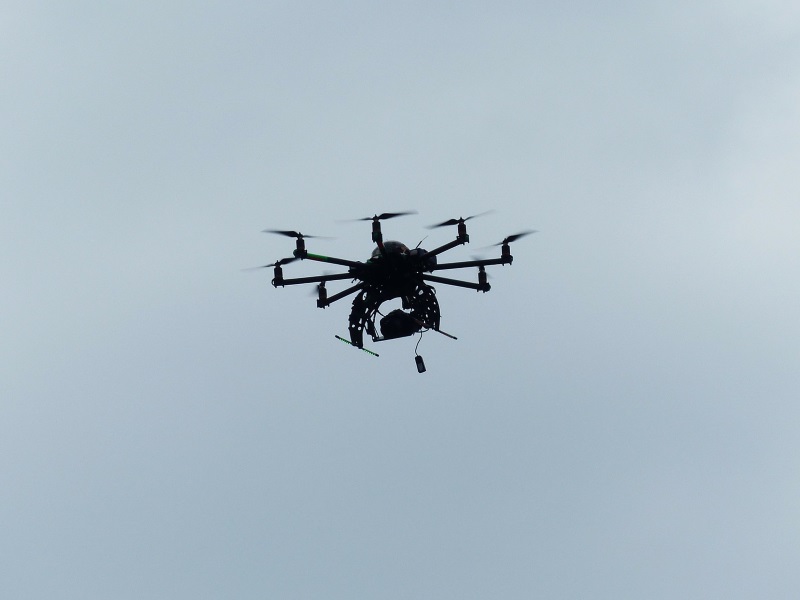- Home
- Transportation
- Transportation News
- To Prevent Drone Airplane Collisions, US FAA Seeks Airport Detection System
To Prevent Drone-Airplane Collisions, US FAA Seeks Airport Detection System

The Federal Aviation Administration said Tuesday that it will explore ways to spot "rogue" drone operations that might collide with planes around airports.
The agency said it has launched an initial research program to evaluate drone detection technology at New York's John F. Kennedy International Airport.
"We face many difficult challenges as we integrate rapidly evolving [drone] technology into our complex and highly regulated airspace," said Marke Gibson, FAA senior adviser on UAS Integration. "This effort at JFK reflects everyone's commitment to safety."
The FAA said there were 764 drones sighted near airplanes last year, despite current guidelines prohibiting flying drones near planes or within five miles of an airport unless the control tower has been contacted first. Drones also are supposed to fly below 400 feet, stay away from stadiums and remain in sight of the operator. (A report that a British Airways plane had been struck by a drone on approach to London's Heathrow Airport later was discounted.)
The FAA began evaluating a drone detection system being used by the FBI this month. The tests at JFK examined the ability of the system to identify five types of drones, including common rotorcraft and more advanced fixed-wing drones.
"We applaud the FBI and FAA for their efforts to detect and track unmanned aerial systems (UAS)," said Thomas Bosco, Port Authority of New York Aviation Director. "We look forward to supporting continued US Government efforts to identify and deploy countermeasures to neutralize the threat posed by rogue UASs."
There has been virtual consensus in Congress that steps must be taken to prevent drone-airplane collisions.
"Unless more is done, it's not if an accident will happen, it's when," Rep. Rick Larsen, D-Wash., said at a hearing of the House subcommittee on aviation last year.
"We don't really know what happens when you suck a quadcopter [drone] into a jet engine," said Rep. Peter DeFazio, D-Ore., who pointed out that a four-pound bird hits a jet moving at 260 mph with the force of 12 tons.
The FAA last year released proposed regulations for drones' weighing less than 55 pounds. They require that the devices remain within the operator's line of sight, cannot operate above anyone not involved with drone operation, can be used only during daylight hours, must yield right of way to other aircraft, can't move faster than 100 miles per hour or at above 500 feet, and that an operator must contact air traffic controllers if operating in airspace they control.
It's estimated that 700,000 drones were sold in the US last year.
© 2016 The Washington Post
Get your daily dose of tech news, reviews, and insights, in under 80 characters on Gadgets 360 Turbo. Connect with fellow tech lovers on our Forum. Follow us on X, Facebook, WhatsApp, Threads and Google News for instant updates. Catch all the action on our YouTube channel.
Related Stories
- Samsung Galaxy Unpacked 2025
- ChatGPT
- Redmi Note 14 Pro+
- iPhone 16
- Apple Vision Pro
- Oneplus 12
- OnePlus Nord CE 3 Lite 5G
- iPhone 13
- Xiaomi 14 Pro
- Oppo Find N3
- Tecno Spark Go (2023)
- Realme V30
- Best Phones Under 25000
- Samsung Galaxy S24 Series
- Cryptocurrency
- iQoo 12
- Samsung Galaxy S24 Ultra
- Giottus
- Samsung Galaxy Z Flip 5
- Apple 'Scary Fast'
- Housefull 5
- GoPro Hero 12 Black Review
- Invincible Season 2
- JioGlass
- HD Ready TV
- Laptop Under 50000
- Smartwatch Under 10000
- Latest Mobile Phones
- Compare Phones
- Realme P4x 5G
- OnePlus Ace 6T
- OPPO A6x 5G
- Samsung Galaxy Z TriFold
- Poco F8 Ultra
- Poco F8 Pro
- Huawei Mate 80 RS Master Edition
- Huawei Mate 80 Pro Max
- Asus ProArt P16
- MacBook Pro 14-inch (M5, 2025)
- Poco Pad M1
- Poco Pad X1
- Just Corseca Skywatch Pro
- Honor Watch X5
- Acerpure Nitro Z Series 100-inch QLED TV
- Samsung 43 Inch LED Ultra HD (4K) Smart TV (UA43UE81AFULXL)
- Asus ROG Ally
- Nintendo Switch Lite
- Haier 1.6 Ton 5 Star Inverter Split AC (HSU19G-MZAID5BN-INV)
- Haier 1.6 Ton 5 Star Inverter Split AC (HSU19G-MZAIM5BN-INV)

















